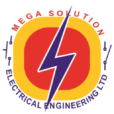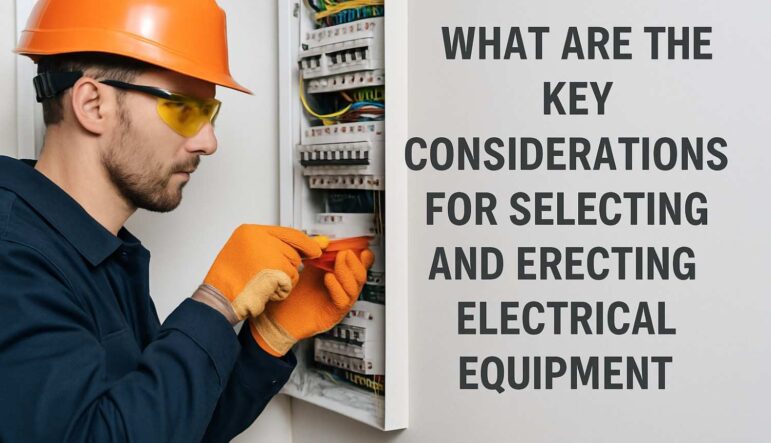Home / Blog Posts / Selecting and Erecting Electrical Equipment
Discover the essential considerations for selecting and erecting electrical equipment, following Ghana Electrical Wiring Regulations 2011 (L.I. 2008) and British Standards. Learn how to ensure compliance, manage operational conditions, maintain compatibility, and safeguard against environmental risks for safe, efficient and durable electrical installations.
The process of selecting and erecting electrical equipment is not just a technical exercise. It is a deliberate safety measure aimed at protecting people, livestock and property from the risks that come with the reasonable use of electrical installations. From the moment equipment is specified to the final connection being made, every choice can determine the reliability, efficiency and safety of the installation.
The Ghana Electrical Wiring Regulations 2011 (L.I. 2008) establish clear requirements for how electrical installations are to be carried out in Ghana. The stated purpose of the Regulations, as set out in Regulation 1(a)–(b), is to establish the requirements, procedures and practices to ensure the enforcement of minimum standards of electrical wiring on premises, and to ensure the safety of persons, livestock and other property from hazards that arise from the presence, distribution and use of electrical energy. This aligns closely with the broader principle in international electrical standards, which is to ensure that installations remain safe for continued use under both normal and fault conditions.
When electrical work is carried out without reference to proper regulations, the consequences can be severe. Fires, electric shocks, system failures, and costly downtime are just a few of the potential results. This highlights the critical importance of the Electrical Wiring Regulations 2011, whose purpose is to ensure the safety of persons, livestock and other property from hazards that arise from the presence, distribution and use of electrical energy.
Regulation 3, titled General principles, mandates that a person undertaking electrical wiring on premises shall do so in accordance with its principles. These principles dictate that a conductor or equipment used for electrical wiring on premises shall be installed and protected to prevent danger to persons and property, and must also be in a state capable of being maintained.
Regulation 3 specifies that equipment should be of a suitable construction and size to prevent excessive temperature rise while in use. If exposed to adverse conditions, it shall be constructed or protected in the manner necessary to prevent danger. Live conductors, enclosures, metalwork, and circuits must all be suitably placed, protected, safeguarded, or connected to earth to prevent danger.
Beyond the general principles, the Regulations explicitly address the full lifecycle of electrical installations:
Installation – Electrical wiring on premises must be carried out in accordance with the requirements provided in the Schedule, which includes the Ghana Standards for electrical wiring. These standards encompass the selection and erection of equipment.
Testing and Inspection – Regulation 11 requires installations to be inspected and tested before use and whenever an addition or alteration is made. It also mandates periodic inspection and testing at specified intervals, with precautions taken to avoid causing danger to persons and damage to property during these tests.
Maintenance – As noted in Regulation 3, equipment must be capable of being maintained. The schedule for periodic inspection and testing under Regulation 11 also takes into consideration the maintenance schedule of the installation.
This makes it clear that safety is not just an afterthought. It is a legal and moral responsibility from the very first step of the installation process. Every piece of equipment, from the largest distribution board to the smallest light fitting, must be chosen and installed with safety in mind.
The journey towards a safe installation begins with compliance to recognised standards, proper assessment of operational conditions, ensuring compatibility and adapting to environmental influences. These form the first stages of selection and erection process.
Compliance with recognised standards is the backbone of safe electrical installation. Electrical equipment is manufactured according to strict specifications and using equipment that has been tested and certified against those specifications ensures a minimum level of safety and performance.
According to Regulation 5 of the Ghana Electrical Wiring Regulations 2011 (L.I. 2008), “all materials and equipment used in electrical wiring and installation works shall comply with the relevant Ghana Standards or where there is no Ghana Standard, with the relevant International Electrotechnical Commission (IEC) standards or other internationally recognised standards.” This requirement ensures that only approved, safe, and reliable materials are used in installations. It mirrors British practice, where equipment must comply with the relevant British Standards (BS) or Harmonised European Standards (EN), thereby ensuring a comparable level of safety and performance.
If a situation arises where no specific Ghana Standard or IEC Standard exists for the equipment in question, the installer or designer is required to ensure that the equipment offers a degree of safety at least equal to that demanded by the regulations. This is not optional. It must also be recorded in the electrical installation certification for traceability and accountability.
For example, fixed equipment, where applicable, should be designed and manufactured in accordance with the Electromagnetic Compatibility (EMC) Directive 2014/30/EU. This ensures the equipment will operate correctly without causing or being affected by electromagnetic interference.
The commitment to compliance extends to every phase of installation. If non-standard equipment is used in a way not originally intended by its manufacturer, the onus is on the designer to prove it still offers equivalent safety. This can involve additional testing, specialist approval or even independent certification.
Adherence to standards is not a bureaucratic exercise. It is the very framework that ensures installations remain safe and reliable for years. Without it, the installation becomes an untested experiment with potentially dangerous consequences.
Selecting electrical equipment is not just about matching physical dimensions or choosing the right brand. It involves carefully assessing the operational conditions in which the equipment will be used.
Equipment must be suitable for the nominal voltage of the installation. This means accounting for both the highest and lowest voltages expected during operation. For example, in IT systems, the equipment must be insulated for the nominal voltage between lines. If the equipment’s insulation is inadequate, it may fail prematurely or present a serious shock hazard.
It must also be designed to handle the design current, which includes not only normal operating current but also currents that might flow under abnormal conditions such as fault currents or temporary overloads. These conditions must be tolerated for the duration determined by the installation’s protective devices.
The frequency rating of the equipment is equally important. If the frequency of the supply affects its characteristics, as in the case of motors, transformers or certain lighting systems, then the equipment must match the nominal frequency exactly to avoid malfunction or inefficiency.
When choosing equipment based on power characteristics, the load factor and normal service conditions must be considered. For example, a motor that will be running continuously in a manufacturing plant must be rated for continuous duty, not just short bursts of activity.
These operational factors are directly related to equipment lifespan, reliability and safety. Choosing equipment without considering them is like buying a sports car and expecting it to pull a heavy trailer up a steep hill every day, it may work for a while but failure will be inevitable.
Electrical equipment does not operate in isolation. Every piece interacts with the rest of the system and poor compatibility can cause problems ranging from nuisance tripping to catastrophic equipment failure.
Equipment must be selected and erected so that it does not cause harmful effects to other equipment or impair the power supply during normal operation, including during switching.
Key considerations include:
One important specification here is the impulse withstand voltage (Uw). This rating must be at least equal to the minimum required for the equipment’s overvoltage category at the point of installation. This ensures it can handle sudden spikes in voltage without insulation breakdown.
Compatibility is not just about electrical characteristics. It also covers operational timing. For example, a protective device must trip fast enough to protect downstream equipment but not so fast that it causes unnecessary interruptions.
Even the best-designed equipment can fail prematurely if it is not suited to the environmental conditions where it will be installed. External influences can include:
If the equipment’s construction is not inherently resistant to these influences, additional protection must be provided. This could include special enclosures, protective coatings, or installation in a sheltered location. However, any additional protection must not interfere with the equipment’s operation. For instance, sealing a piece of equipment inside a box for water protection could cause it to overheat if ventilation is not maintained.
In Ghana, installations in coastal areas often face a combination of high humidity and salt-laden air, which can accelerate corrosion. Choosing stainless steel enclosures or applying anti-corrosion treatments can significantly extend equipment life in such conditions.
The selection of protective devices is one of the most critical decisions in electrical installation work. Protective equipment acts as the first line of defence against electrical faults, overcurrents, and other dangerous conditions. If incorrectly specified, these devices can fail to operate when needed or operate unnecessarily, leading to system downtime and potential hazards.
Key protective devices include circuit-breakers, Residual Current Devices (RCDs), and Surge Protective Devices (SPDs). Each serves a distinct purpose. Circuit-breakers protect against overloads and short circuits, while RCDs protect against electric shock by detecting leakage currents. SPDs safeguard sensitive equipment from transient overvoltages caused by lightning or switching operations.
The Ghana Electrical Wiring Regulations 2011 (L.I. 2008) align with these principles. Regulation 3(5) requires that “a circuit shall be protected against the persistence of excessive current which is likely to cause danger by the use of an appropriate circuit breaker or fuse.” This reflects the same core principle found in the IET Wiring Regulations (BS 7671), where protective devices must be selected to match the circuit characteristics and provide effective protection against overcurrent conditions.
Devices for isolation and switching must comply with relevant requirements such as those found in Chapter 46 and Section 537 of BS 7671. One important point is that semiconductor devices are not acceptable as the sole means of isolation, since they cannot guarantee physical separation of contacts.
When selecting protective equipment, one must consider:
This careful selection ensures that when a fault occurs, the protective device will operate quickly, accurately, and without unnecessary disruption to unaffected parts of the system.
The best-designed electrical system can still fail if poor workmanship or substandard materials are used. Workmanship refers to the skill and attention to detail applied during installation, while materials refer to the physical components used.
Regulation 3 of the Ghana Electrical Wiring Regulations states that all wiring and installation work must be “executed by certified electrical wiring professionals using approved wiring methods and materials”. This means installations should only be carried out by skilled or instructed persons, following established procedures and using appropriate tools.
Good workmanship includes:
Equally important is adherence to manufacturer’s instructions. Every piece of electrical equipment is supplied with specific guidance for safe installation, which you must follow to avoid voiding warranties or reducing performance.
Material selection is equally critical. Inferior cables, switches, or fittings can quickly degrade, especially in harsh environments. For example, cheap plastic enclosures may become brittle under prolonged sun exposure, leading to cracks and water ingress.
By combining skilled workmanship with durable, certified materials, installers ensure that the electrical system remains safe, functional, and easy to maintain over its lifespan.
Selecting the right equipment is only half the job. The way it is installed can either preserve or destroy its safety characteristics. For example, a circuit-breaker designed to operate at a certain temperature may fail prematurely if installed in a location with inadequate ventilation.
During erection, the installer must ensure that nothing is done to impair the characteristics determined during the selection process. This includes:
If these precautions are ignored, the equipment may no longer meet the safety standards it was designed for, even if it was originally compliant. This is why Regulation 5 of L.I. 2008 and BS 7671 both emphasise preserving the manufacturer’s safety specifications during installation.
The principle is simple: installation should enhance equipment safety, not compromise it.
Electrical connections are the hidden lifelines of any installation. Even the highest quality cable and equipment will fail if the connections between them are poorly made. Connections must provide durable electrical continuity, adequate mechanical strength, and appropriate protection against environmental damage.
Regulation 5 of the Ghana Electrical Wiring Regulations requires that “all connections shall be made using approved methods that ensure proper contact pressure and protection against corrosion”. This aligns with BS 7671 Section 526, which outlines requirements for the mechanical and electrical integrity of joints.
When selecting connection methods, the installer must consider:
Soldering is not permitted for the entire conductor end of multiwire or fine-stranded conductors where screw terminals are used, or in locations subject to movement. This is because solder can creep under pressure and loosen over time, leading to overheating.
Common best practices for connections include:
These practices ensure that connections remain secure and electrically sound throughout the life of the installation.
Electrical equipment generates heat during operation, and poor temperature management can lead to reduced lifespan, fire hazards, and even catastrophic failure.
Equipment must be installed so that its design temperature is not exceeded. This often requires providing adequate ventilation, avoiding direct exposure to heat sources, and allowing space around components for air circulation.
Some equipment, such as resistive heaters or high-power lighting fixtures, can reach very high surface temperatures. Regulation 5 of L.I. 2008 and BS 7671 both require that such equipment be installed or guarded to prevent burns to persons or livestock and to minimise fire risks.
In practice, this might involve:
For example, a fixed electric heater installed too close to a wooden partition could cause scorching or even ignition over time. The use of fire-resistant mounting boards can eliminate this risk.
Proper temperature management not only enhances safety but also extends the operational life of electrical equipment by preventing thermal stress on insulation, terminals, and other components.
Accessibility is often overlooked in electrical installations, yet it is a crucial factor in ensuring safety, reliability, and ease of maintenance. A difficult-to-reach installation can become a long-term liability because people may neglect inspections, repairs, or upgrades.
The arrangement of electrical equipment must allow sufficient working space for initial installation, replacement, testing, fault detection, and maintenance. This means more than just being able to reach the equipment, it includes having adequate lighting, safe access routes, and clear labelling.
Regulation 5 of the Ghana Electrical Wiring Regulations reflects this, stating that “equipment shall be so arranged as to provide adequate space for operation, inspection, testing and maintenance without risk to persons”. The implication is that cramped switchgear rooms, inaccessible consumer units, or tightly packed cable runs are not acceptable if they compromise safety.
Accessibility considerations include:
Accessibility also benefits long-term system performance. If you can easily inspect and test the equipment, you can detect faults earlier which will prevent them from developing into costly failures.
Electrical installations often share space with other electrical and non-electrical systems, such as data cabling, plumbing, gas pipes, and HVAC ducts. If not carefully planned, these systems can interfere with each other.
The key principle is that different systems should not cause mutual harm. For example:
The Ghana Electrical Wiring Regulations support this by requiring that “wiring systems shall be so arranged as to avoid harmful influence between electrical and non-electrical installations”. This may involve physical separation, use of screened cables, or fitting barriers inside trunking and conduits.
Electromagnetic interference (EMI) is a particular concern in modern installations with increasing use of sensitive electronics. Correct routing, shielding, and bonding practices ensure that equipment operates reliably without disruption from neighbouring systems.
The selection and erection of wiring systems is a fundamental aspect of any electrical installation. Choose wiring systems not only for their electrical capacity but also for their ability to withstand the environmental and mechanical stresses of the location.
External influences such as temperature, humidity, corrosive substances, and mechanical impact play a large role in determining cable type. In Ghana, for instance, installations in industrial plants may require armoured cables to resist impact and chemical exposure, while rural installations might require UV-resistant sheathing for outdoor runs.
Other key wiring system considerations include:
Regulation 5 of L.I. 2008 reinforces that wiring systems should be installed in a manner that minimises flame propagation and prevents danger in the event of a fault.
Correct cable routing is also critical. Keep cables at safe distances from other services to avoid heat build-up or damage. For example, running cables parallel to hot water pipes can cause premature insulation failure unless you provide thermal separation.
Protective devices and switches are not just functional components; they are active safety mechanisms that prevent injury, equipment damage, and fire.
In line with BS 7671 and the Ghana Electrical Wiring Regulations, single-pole fuses, switches, or circuit-breakers must only be inserted in the line conductor, never in the neutral alone. This ensures that when the device operates, the circuit is completely isolated from live supply potential.
For earthed neutral systems, you must arrange any linked switch or circuit-breaker in the neutral to break all related line conductors simultaneously. This prevents dangerous situations where a neutral disconnects while line conductors remain live.
Protective switching devices must also be:
Failure to follow these rules can lead to hazardous situations, such as equipment appearing to be isolated when it is still energised.
The way we fix equipment in place can significantly affect its performance, safety, and lifespan. Poorly mounted equipment can lead to loose connections, vibration damage, and exposure to environmental hazards.
Connections between wiring and equipment must not be under undue strain. This means we ensure cables are supported, correctly aligned, and not twisted or bent excessively at the point of entry.
You must mount unenclosed equipment in a suitable box or enclosure that offers mechanical protection and prevents accidental contact with live parts. When installing equipment on cable trunking, do not fix it to removable covers, as this can lead to accidental disconnection or damage during maintenance.
In environments subject to vibration, such as industrial machinery rooms, additional measures like locking washers, anti-vibration mounts, or flexible connections may be necessary to maintain secure fixing over time.
The Ghana Electrical Wiring Regulations highlight that fixing methods should ensure long-term safety and reliability, especially in areas accessible to the public or untrained personnel.
Selecting and erecting electrical equipment is far more than a matter of technical preference or brand choice. It is a structured process that must take into account compliance with national and international standards, operational conditions, compatibility with other systems, and resistance to environmental factors.
Taken together, Regulations 3 and 5 provide a solid legal and technical framework for the selection and erection of electrical equipment in Ghana. While the specific wording may differ from British Standards and the IET Wiring Regulations (BS 7671), the fundamental principles of electrical safety are consistent across these systems.
From selecting protective devices with the correct fault-breaking capacity to ensuring that connections are mechanically and electrically sound, every step in the process is about managing risk. Attention to workmanship, adherence to manufacturer’s instructions, and preservation of equipment characteristics all play vital roles in ensuring that installations remain safe, reliable, and efficient for years.
Moreover, considerations such as accessibility for maintenance, prevention of interference between systems, and the correct fixing of equipment ensure that safety and performance do not degrade over time. These factors are not optional extras, they are integral to achieving compliance and ensuring public safety.
Ultimately, the goal is the same in Ghana as it is in the United Kingdom or any other country with strong electrical safety laws: to safeguard people, animals, and property from the dangers inherent in electrical installations. This is achieved by combining compliance, careful planning, skilled workmanship, and ongoing maintenance.
Trustindex verifies that the original source of the review is Google. I hired a licensed electrician from mega solution electrical in Kumasi, the service was done professionally and met all standards. It gave me peace of mind. I will recommend them to every bodyPosted onTrustindex verifies that the original source of the review is Google. They’re the best and most reliable electrical company in Ghana I’ll always recommend them to everyonePosted onTrustindex verifies that the original source of the review is Google. Thanks for solving our electrical problem so fast, coming all the way to Cantonments.Posted onTrustindex verifies that the original source of the review is Google. Mega Solution demonstrates exceptional expertise in genset systems. Their professionalism, technical proficiency, and industry experience set them apart. I highly recommend their services to anyone seeking reliable and knowledgeable partners in this field.Posted onTrustindex verifies that the original source of the review is Google. This best experience I had in a while, Richard provided all the help I was looking for. Thank you, this is a 10 Stars service!Posted onTrustindex verifies that the original source of the review is Google. Best electrical company in GhanaPosted onTrustindex verifies that the original source of the review is Google. Best Electrician in Ghana | best electrical engineer at good location | over 30 years experience | good electrical service. Thank you so much. I’m very happyPosted onTrustindex verifies that the original source of the review is Google. Wonderful work you have to try
When searching for a reliable electrician, call us at +233 24 415 1232 We specialize in electrical repairs, indoor and outdoor lighting installations, panel upgrades, and even hot tub wiring!
No matter urgent any electrical repairs seem, it’s never okay to attempt to handle them on your own. Trying to take care of electrical problems without professional training is extremely dangerous. If you or someone else aren’t hurt during your attempt, there’s still a chance that you’ve left something undone that poses a huge risk to you, your home, or your family.
mega solution electrical Power and wiring audit in Accra, Ghana knows what a hassle any electrical problems can be, which is why we’ll always respond to any requests for service as quickly as possible. And because all of our technicians are licensed, background checked, and professionally trained, you’re guaranteed to receive the best quality service and workmanship available when you call us. We can assist with all your electric needs including:
| M | T | W | T | F | S | S |
|---|---|---|---|---|---|---|
| 1 | 2 | 3 | 4 | |||
| 5 | 6 | 7 | 8 | 9 | 10 | 11 |
| 12 | 13 | 14 | 15 | 16 | 17 | 18 |
| 19 | 20 | 21 | 22 | 23 | 24 | 25 |
| 26 | 27 | 28 | 29 | 30 | 31 | |

Learn how to read and understand circuit breaker ratings like In, Icu,
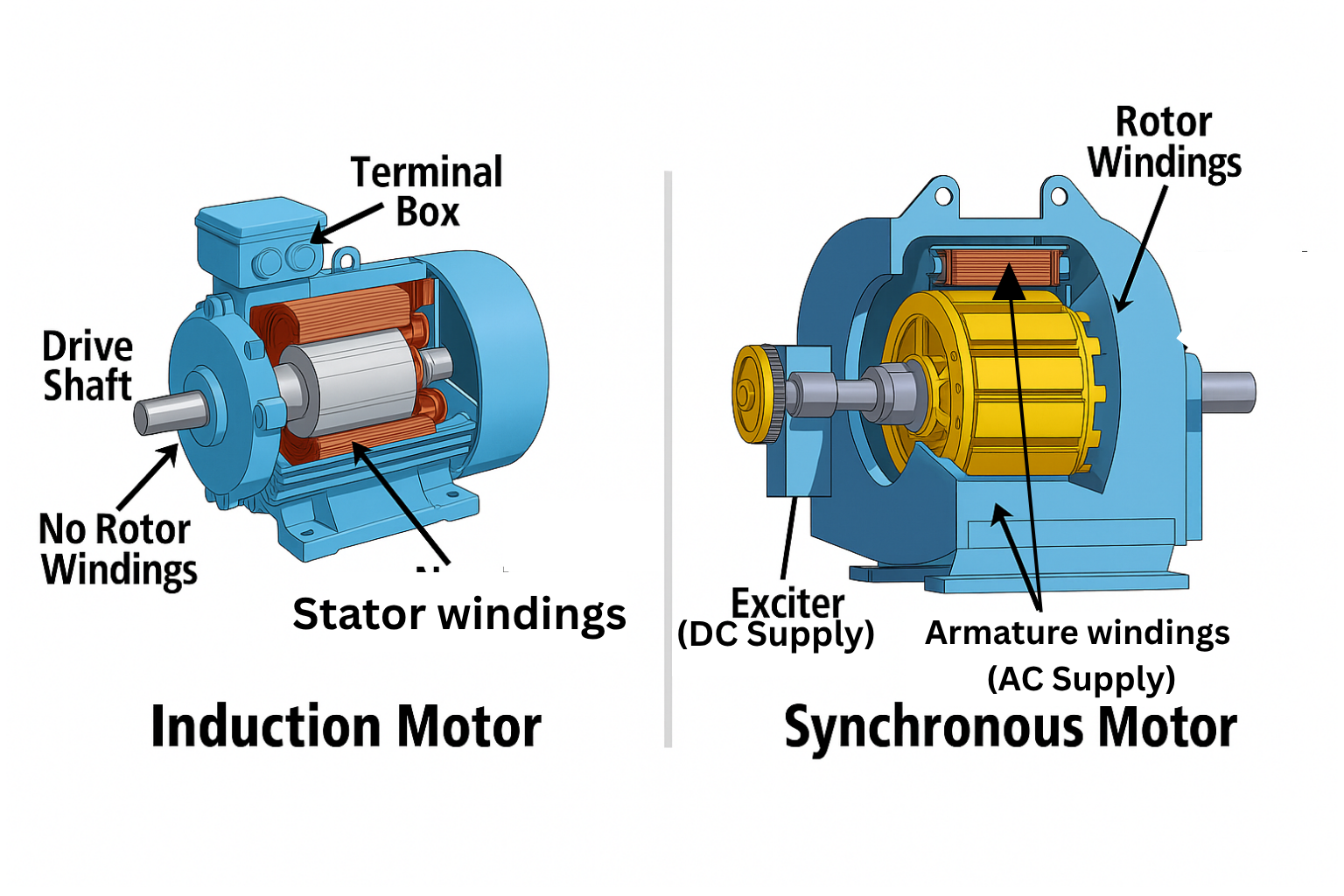
Discover the key differences between synchronous and induction motors.

What safety measures you need to put in place in your industry and why

As energy bills continue to soar, households and businesses alike are
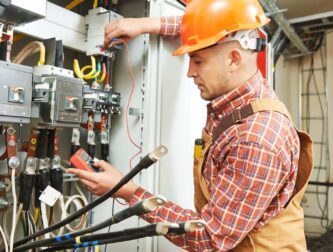
Dreaming of a Career as an Electrician in Ghana? Here's How to Make It
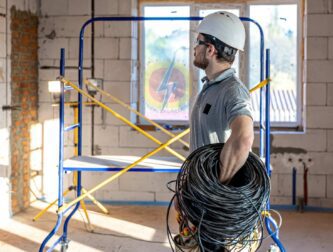
Characteristics of Top Electricians Before starting your search, it's

